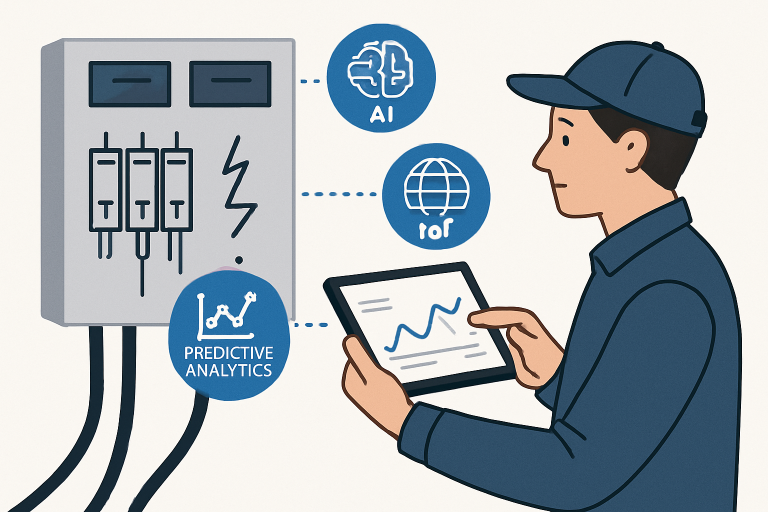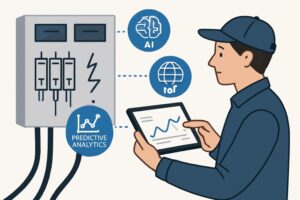Key Takeaways
- Predictive maintenance, powered by AI and IoT, is transforming equipment upkeep.
- Sustainability practices are becoming integral to maintenance strategies.
- Immersive technologies like AR and VR enhance training and execution.
- Decentralized maintenance models offer flexibility and efficiency.
- Edge computing enables faster, localized decision-making.
Table of Contents
- Introduction
- Predictive Maintenance with AI and IoT
- Sustainability Practices in Maintenance
- Immersive Technologies: AR and VR
- Decentralized Maintenance Models
- Edge Computing in Maintenance
Electrical equipment maintenance is crucial in today’s industrial landscape, which is driven by technological advancements like AI, IoT, and edge computing. These technologies are transforming routine maintenance and enabling companies to anticipate issues before they escalate. Companies should explore advanced testing and refurbishment services—such as those offered by Divergent Alliance electrical equipment testing—to stay ahead in safety, flexibility, and compliance. Understanding these trends helps organizations adopt sustainable practices, optimize asset performance, and meet rising standards in the digital age.
Predictive Maintenance with AI and IoT
The transition from traditional maintenance—relying on routine schedules and reactive repairs—to data-driven predictive strategies marks a significant leap for facility management. Through the integration of AI and IoT, companies can continuously monitor electrical assets in real time using advanced arrays of connected sensors. These devices capture critical information such as operational temperature, vibration patterns, and fluctuations in power quality. Sophisticated AI analytics then scrutinize this data, searching for key wear indicators, abnormal operating conditions, or the earliest signs of component degradation. This proactive approach shifts maintenance from calendar-driven to need-based, enabling interventions before problems cause disruption.
Predictive maintenance sharply reduces costly downtime and transforms resource allocation. Maintenance teams are now empowered to respond precisely, traveling or mobilizing only where diagnostics indicate an impending issue. As a result, labor hours are used far more efficiently, and the likelihood of catastrophic failure is minimized. Additionally, equipment serviced precisely when necessary tends to last longer, resulting in deferred capital expenditures and lower overall maintenance costs.
Benefits of Predictive Maintenance
- Reduced Unplanned Downtime: Identifying vulnerabilities early keeps power systems and processes running reliably, aligning with the demands of critical 24/7 operations.
- Optimized Resource Use: Maintenance resources and personnel are focused on areas of greatest need, maximizing return on investment for maintenance budgets.
- Lower Lifecycle Costs: Timely responses extend equipment lifespan and stave off major failures that require expensive replacements or emergency services.
Utilizing best-in-class testing protocols, such as those developed by Divergent Alliance, provides essential accuracy and reliability, ensuring that predictive maintenance programs remain robust and future-ready as technology advances.

Sustainability Practices in Maintenance
Integrating sustainability into maintenance strategies is no longer limited to environmental compliance—it is now integral to brand credibility and business growth. Electrical equipment often represents a significant portion of an organization’s environmental impact due to high energy consumption and the use of materials that may present disposal or contamination challenges. Innovative leaders spearhead environmentally conscious alternatives and greener work methods throughout the equipment lifecycle.
To minimize ecological damage, forward-thinking organizations implement maintenance routines incorporating eco-friendly lubricants, solvents, and cleaning agents. Recycling initiatives are being expanded; obsolete components and scrap materials are repurposed or safely recycled, diverting significant waste from landfills. Efficiency upgrades such as adopting variable frequency drives, energy-saving lighting, and automated control systems are prioritized to curb unnecessary energy use. Energy monitoring systems gather granular consumption data, empowering managers to pinpoint and eliminate inefficiencies.
- Using biodegradable lubricants and other eco-friendly maintenance products
- Recycling or repurposing aging components
- Prioritizing upgrades that improve energy efficiency, such as variable frequency drives and smart controls
- Implementing monitoring systems to track and reduce energy waste
Beyond the moral imperative, the business case for green maintenance is growing stronger. Embracing sustainability brings cost savings via reduced energy usage, unlocks eligibility for government incentives, and shields companies from escalating environmental surcharges. This commitment enhances public perception, builds stakeholder trust, and establishes resilience in anticipation of evolving regulations and customer preferences.
For organizations interested in deepening their sustainable maintenance strategies, industry leaders like those showcased in this U.S. Department of Energy guide offer valuable insights into efficient, compliant electrical system maintenance.
Immersive Technologies: AR and VR
Training and operational support have undergone a digital revolution thanks to immersive technologies such as Augmented Reality (AR) and Virtual Reality (VR). AR overlays context-rich information—including wiring diagrams, operational procedures, or live troubleshooting data—on a technician’s real-world environment. This immediate visual guidance proves invaluable when navigating complex repairs or installations, drastically decreasing guesswork, downtime, and risk of human error.
Meanwhile, VR is redefining how teams learn and rehearse maintenance tasks. By immersing workers in interactive simulations of electrical systems, VR enables safe training that mimics real-life challenges without the danger to personnel or infrastructure. Trainees build familiarity with rare hazards, practice emergency response, and reinforce best practices in a fully controlled, risk-free context. These virtual experiences dramatically enhance onboarding efficiency and knowledge retention.
Key Outcomes of AR/VR Adoption
- Enhanced technician proficiency and safety, translating to fewer on-the-job accidents and improved quality of work
- Decreased mean time to repair, ensuring prompt restoration of services
- Lower maintenance-related incidents or catastrophic mistakes contribute to a safer, more reliable operational environment.
To explore case studies and in-depth guidance on implementing immersive technologies, this Plant Engineering article details how AR and VR transform electrical maintenance.
Decentralized Maintenance Models
As operational networks expand and assets become more dispersed, the traditional model of centralized maintenance is being outmoded by more agile decentralized approaches. The widespread adoption of remote monitoring tools and mobile connectivity supports distributed maintenance teams who can coordinate seamlessly across large, multi-site enterprises. These teams are no longer bound by rigid schedules or the need for constant on-site staffing; instead, they respond dynamically to real-time alerts and diagnostics from virtually anywhere.

Cloud-based collaboration platforms are pivotal in driving this trend, enabling efficient resource allocation, documentation management, and secure partner collaboration regardless of geography. Maintenance becomes much more scalable and responsive, with the ability to shift tools, personnel, and technical expertise to the point of need rather than maintaining a costly on-site presence at every location.
- Monitor multiple remote locations without permanent on-site staff
- Allocate resources dynamically according to evolving maintenance needs
- Collaborate securely with external service providers and vendors
Decentralized models reduce operational overhead, speed up incident response, and empower organizations to adapt quickly to change. They leverage shared digital data, coordinated workflows, and integrated communication to maintain high performance even in complex and shifting scenarios.
Edge Computing in Maintenance
The proliferation of innovative equipment means that electrical devices generate unprecedented volumes of data every second. Traditional cloud-based processing can introduce delays, especially in remote facilities with limited bandwidth. With edge computing, analytical processing occurs locally—directly at the equipment or on-premises—enabling instant analysis and automation in decision-making. This is particularly beneficial for time-sensitive applications such as fault detection, system optimization, and rapid incident intervention.
- Increased Data Security: By handling sensitive operational information on-site, organizations strengthen their defense against cyber risks and data breaches.
- Real-Time Insights: Local analytics provide immediate feedback for operators and systems, allowing split-second adjustments that can prevent anomalies from escalating.
- Resilience: Even amid network disruptions or outages, edge systems continue to function autonomously, preserving visibility, safety, and continuity until connections are restored.
Edge computing is the backbone for future-ready, autonomous facilities, ensuring businesses can maintain the highest uptime, efficiency, and protection regardless of the external environment.
In summary, the evolution of electrical equipment maintenance is unmistakable, charting a course defined by advanced technologies, environmental responsibility, and operational adaptability. Organizations embracing these trends—from AI-driven predictive maintenance to sustainable operations, immersive training, decentralized management, and localized edge analytics—will set the standard for reliability and success in an increasingly complex digital world.
